The Standard Shower Valve Height From the Floor
Author: Omar Alonso | Editor: Omar Alonso
Review & Research: Jen Worst & Chris Miller
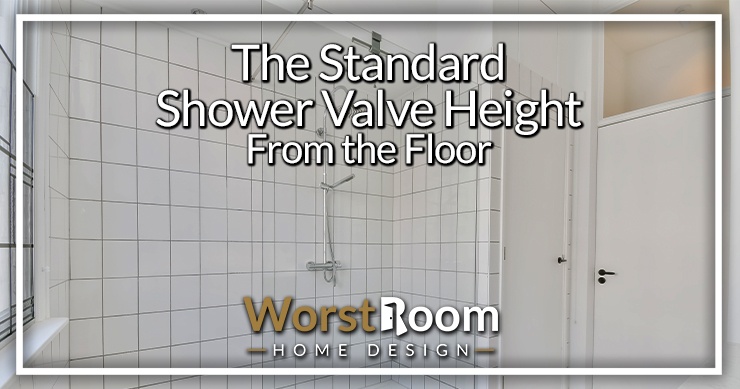
As a homeowner, choosing the right shower valve height can pose a dilemma since there are so many options. The incorrect shower faucet height choice can result in not only a subpar shower performance but also an uncomfortable and inconvenient showering experience.
Understanding the importance of the height of a shower valve is crucial in ensuring that your wash time is comfortable and convenient. This article aims to provide you with the necessary information and tips to make an informed decision and elevate your shower session.
Standard Shower Valve Height From the Floor
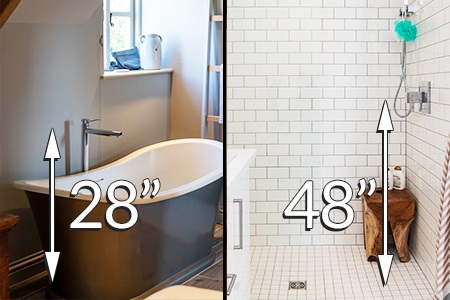
The height of a shower valve varies based on the type of shower. For showers inside a bathtub, the standard height is 28 inches from the floor, while for free-standing showers (also called shower stalls), the height is 48 inches from the floor as the maximum height.
Shower Valve Purpose & Types
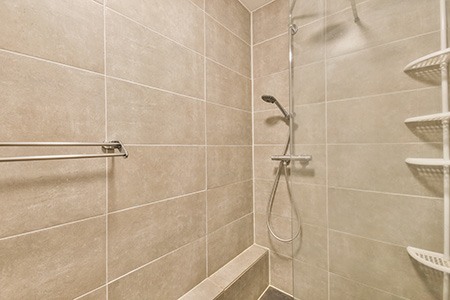
Shower valves regulate the water flow and temperature in your shower through a knob or lever, typically located behind the wall. Different types of shower valves are available, each with its own unique features and benefits. Here are some of the most common types:
- Pressure-balancing valve
- Hot and cold valve
- Thermostatic valve
- Diverters and transfer valve
- Manual valve
While it’s helpful to understand which type of shower faucets and valves within you have, it won’t effect the height you need to mount it at. It may effect how you mount it though, so please familiarize yourself with your specific shower valve type.
The Importance of the Shower Valve Height
The shower valve’s placement is critical for a comfortable and easy showering experience. When a valve is too high, it can be difficult to access, especially for children or people with disabilities, and may result in an uncomfortably strong water flow that’s hard to control. On the other hand, a valve that is too low can interfere with showering and produce a weak water flow.
Shower valves need to be placed in a spot that is easily accessible for people of all heights. The valve’s height from the floor should be such that it’s easy to adjust the water pressure and temperature without bending down or reaching up.
Factors That Affect Shower Valve Height
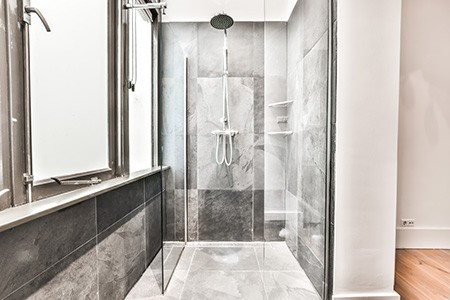
When it comes to determining the right height of a shower valve, homeowners have to consider the following:
Plumbing Codes
Building codes have established the standard height for shower valves. Hence, it’s crucial to work with a knowledgeable licensed plumber who understands the local and international plumbing codes and regulations, as well as industry standards.
Doing so will guarantee the shower valve is installed at the correct height and in compliance with the codes. There’s a code for everything, from a shower height code for the proper height of a shower door, to clearances for those doors, the height of the shower head, and so much more to consider. Even rules for a toilet room’s dimensions come into play.
Bathroom Shower Type
The bathroom shower type can significantly impact the height of the shower valve. Different shower designs come with varying requirements for valve placement. Here are the most common shower types and how they can affect the shower faucet height:
- Custom Showers: Around 48 inches above the floor
- Walk-in Showers: Around 48 inches above the floor
- Glass Enclosure Showers: Around 48 inches above the floor
- Neo-Angle Showers: Around 48 inches above the floor
- Corner Enclosure Showers: Around 48 inches above the floor
- Bathtub Shower Combination: Average shower valve height is 28 inches above the floor
- Rain Shower: Shower valves can be positioned 50 inches above the bathroom floor
- Tub-Shower Combination: Shower valves are fixed below the tap for accessibility
- Shower Tower or Body Shower: May require valves at varying positions
As you see, the 48 inch number appears frequently. Not only is it the maximum allowable height but it’s the most comfortable and convenient to operate when standing or sitting, in accordance to ADA compliance code. There are scenarios where you are allowed to exceed 48 inches as described above.
Shower Head Types
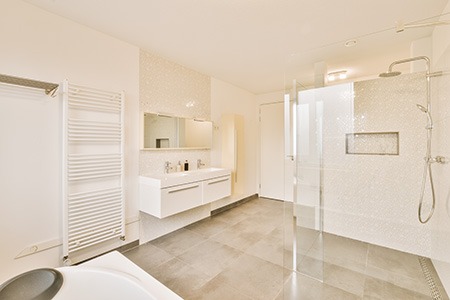
Different shower heads are available in the market, such as:
- Single-spray
- Detachable
- Rainfall
- LED Shower Head
When determining the right height for your shower valve, your shower head’s height is a crucial factor to consider. The standard height for shower heads is typically around 80 inches from the floor, but this can vary based on the height of your ceiling and the individuals who will be using it.
To ensure the optimal angle and direction of water flow, most plumbers suggest a minimum shower head height of 72 inches from the shower pan.
However, if there are taller individuals in your household, you may choose to make it higher. You also have the option of installing multiple shower heads or using a handheld shower head to accommodate individuals of different heights.
It’s important to note that every time you move the shower head or other fixtures, the distance between the fixtures will also change.
Users’ Height
When installing your shower fixtures, including the valves, it’s crucial to consider the needs of everyone who will use the bathroom, including family members and visitors with special requirements.
Likewise, you can locate your shower valves at the recommended height according to the Americans With Disabilities Act (ADA), which sets the standard height for control knobs in shower stalls at 38 to 48 inches.
However, the standard shower valve height may not be ideal for every household, particularly those with family members over 6ft tall or under 5ft.
Personal Needs
When choosing the height for shower valves, personal style, and aesthetic preferences also play a crucial role. The valve’s height ensures functionality and also achieves a visually pleasing appearance.
The shower layout is a significant factor that affects the ideal height for the valves. If a built-in bench or seating area is present in the shower, the valves should be located at a height that allows easy access when seated.
A variety of shower valve styles are available for consideration, including contemporary and traditional designs. These valves can serve as decorative elements in the bathroom and can be selected to align with personal taste and the overall design scheme.
Installing Shower Valves
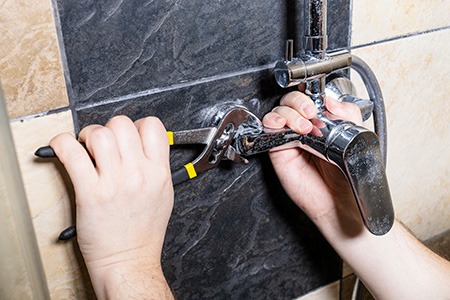
Installing a shower valve involves several steps to ensure proper placement and connection to the pipes:
- Measure and determine the appropriate height for the shower valve and drop-ear elbow.
- Next, attach a backer board to the stud walls. Dry fit the tile and use it to determine the correct measurements for the blocking wood, which should then be securely set in place.
- Connect the riser pipes to the shower valve and prepare the copper pipes.
- After applying flux to the pipe and drop-ear elbow, overhang the copper pipes and solder them with a trigger-start torch. During this step, be mindful to protect the walls with pads.
- After soldering, wipe away any excess flux and repeat the process for all remaining connections.
You must remove any flammable or fragile components from the valve before soldering for safety. You can reattach them once all connections have been made. Some of these steps may be different if you’re using other types of pipes such as PEX (PVC is only to be used with drain lines).
If you’re skilled in plumbing and are confident in your ability, you can consider installing a shower valve yourself. However, it’s recommended to hire a professional for the job if you’re unsure or unfamiliar with the process and materials involved.
Make you install the valve in the proper orientation so you can not only tell if the valve is open or closed but you know which side is conventionally hot or cold.
Adjusting the Shower Valve Height
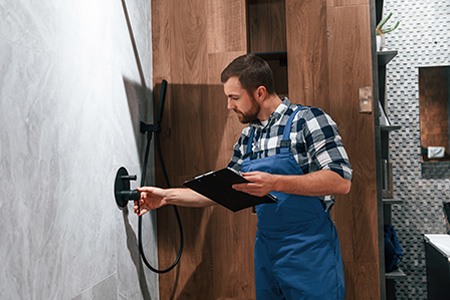
A common problem faced by many people is that the shower valve may not be positioned at the desired height, causing inconvenience and discomfort during showering. To address this issue, several methods are available for adjusting shower valves:
Nail Height Adjustment
In this technique, the current valve must be ground down and a new one installed with replacement screws. An adjustable height plate is used to replace the old plate. You can make height adjustments as needed.
Screw Height Adjustment
This method involves removing the valve as with the nail height adjustment but using the same screws that held the original valve. The new adjustable valve is screwed into the same location as the old one but with room for height adjustments.
Self-Cleaning Mechanism
This type of adjustable shower valve moves up and down in conjunction with the shower head, eliminating the need to adjust both separately.
Manually Operated Mechanism
This type of shower valve requires a mechanical inverter or hand tool to adjust the height to the desired level.
Commercial Adjustable Valves
Some commercial shower valves allow for adjustable valves to be installed on the wall, eliminating manual installation issues.
The Standard Height of a Shower Valve Explained
It’s essential to note that while personal preference is an important consideration in a bathroom renovation, it’s always best to consult with a professional plumber for expert advice and proper installation according to the shower height code.
Ensuring the safety and satisfaction of your bathroom should always be a priority. Your bathroom should be a place of comfort, and having the right shower valve height can contribute to that.



